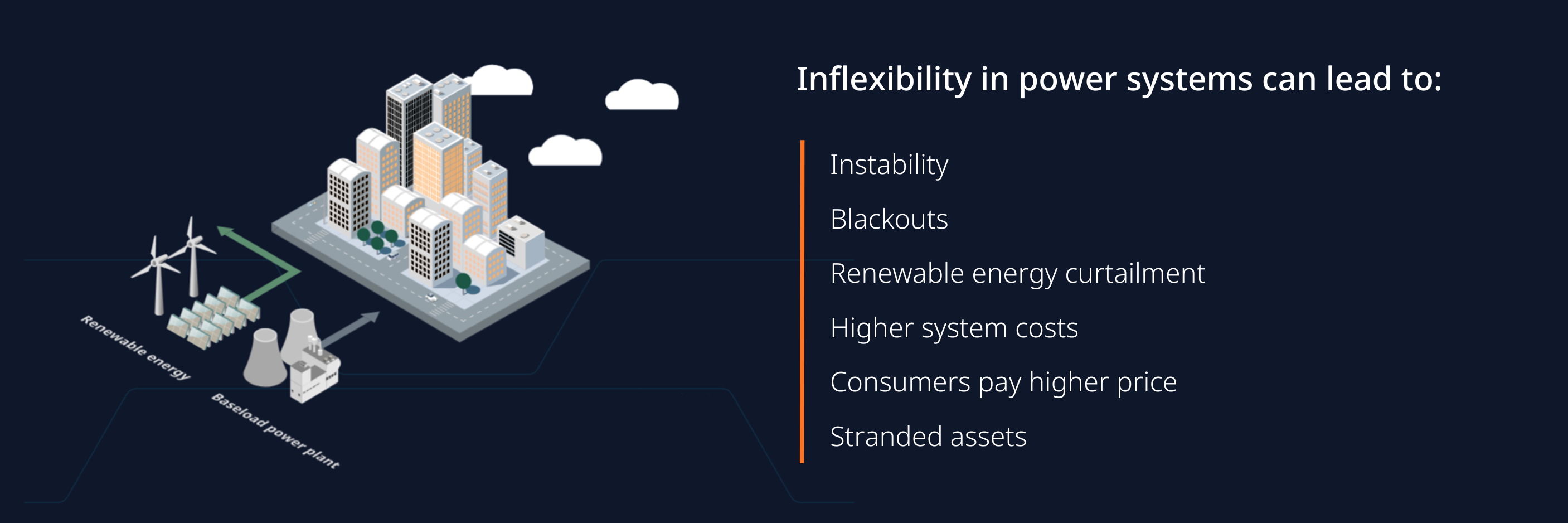

Our window to reduce emissions and keep our planet habitable is closing. To meet the climate goals set out in the Paris Agreement and to prevent global temperature from rising above 1.5C, we need carbon emissions to peak by 20251 and halve by the end of this decade. To do this, we must triple renewable energy by scaling investment fourfold from USD 1.3 trillion in 20222 to USD 5.7 trillion per year by 20303.
But simply scaling renewables will not deliver the clean and resilient future energy system we need. We must build a more flexible energy system to support a renewable future.
The technologies, expertise and finance needed for a greener future are available now and there is no time to waste. That is why Wärtsilä has launched Every Second Counts, a campaign to call on policy makers and the energy industry to follow three core principles to create a flexible future.
Three principles for our flexible energy future
Based on our modelling and expertise, we have outlined three crucial principles to follow when designing future power systems:
1) Ensure that we are choosing the right technologies. The build out of wind and solar power must be matched with flexible grid balancing engines and energy storage to ensure the optimal, lowest cost power mix and secure grid stability and reliability.
2) Redesign our energy markets to support flexibility. There should be proper market mechanisms for procuring, using and paying for ancillary services, which will encourage investments in flexibility solutions. For example, creating capacity markets to ensure developers are rewarded for their investments in flexible capability, even if a plant runs only intermittently to balance demand.
3) Introduce shorter timeframes i.e., using 15- or even 5-minute time resolution in the power market trading instead of one hour to reduce the imbalance within the hour. This will also serve to improve the planning of the power grid, delivering a more precise system that requires less reserve capacity.
By collectively embracing these principles, we can build a future energy system that efficiently and effectively supports the mass scaling of renewable energy.

The inflexibility challenge
For generations, we have been reliant upon traditional, inflexible power plants, such as coal, combined-cycle gas turbines and nuclear to provide baseload power for our energy grids. These traditional power systems now need to adapt, as renewable energy is expected to meet 35% of global power generation by 2025.
As wind and solar power is intermittent, running them alongside inflexible baseload power plants, which cannot quickly ramp up and down to match the changing levels of renewable power, can create significant issues, such as instability or unreliability for power grids.
A lack of flexibility often leads to renewables being switched off, or curtailed, as it is cheaper and easier to stop wind and solar from generating power than it is to switch off or ramp down a baseload power plant.
As the level of renewable power on our grids increases in the coming years, a large share of these inflexible power plants will become obsolete, uneconomical stranded assets in our power grids.
We therefore need to combine the build out of renewables with a substantial increase in flexible capacity, such as grid balancing engines and energy storage, which can quickly ramp up and down to support wind and solar power.

Building power systems of the future
Our studies and modelling of over 190 energy systems have found that anywhere in the world, the most cost-effective approach to reach 100% renewable energy is to combine renewable power with flexibility in the form of grid balancing engines and energy storage.
For example, Europe can cut its power sector gas consumption in half, reduce energy costs by USD 356 billion and increase energy independence by 2030 if it rapidly scales up its renewable capacity and flexibility.
But the path to net zero is not linear and the last few years have demonstrated that we cannot see exactly what is around the corner. Therefore, policy makers must establish market conditions and policies to enable us to build flexibility into power systems today and ensure they’re adaptable for tomorrow.
Our three principles can act as a guiding light for policy makers around the world to follow in shaping our energy future.
Every second counts.
Discover how flexibility can be added to ensure our power systems are fit for the future

2 Global landscape of renewable energy finance 2023
3 Investment Needs of USD 35 trillion by 2030 for Successful Energy Transition
4 Compared to the baseline modelling in the IEA’s Renewables 2021 forecast: https://www.iea.org/reports/renewables-2021/renewable-electricity?mode=market®ion=Europe&publication=2021&product=Total
Did you like this? Subscribe to Insights updates!
Once every six weeks, you will get the top picks – the latest and the greatest pieces – from this Insights channel by email.